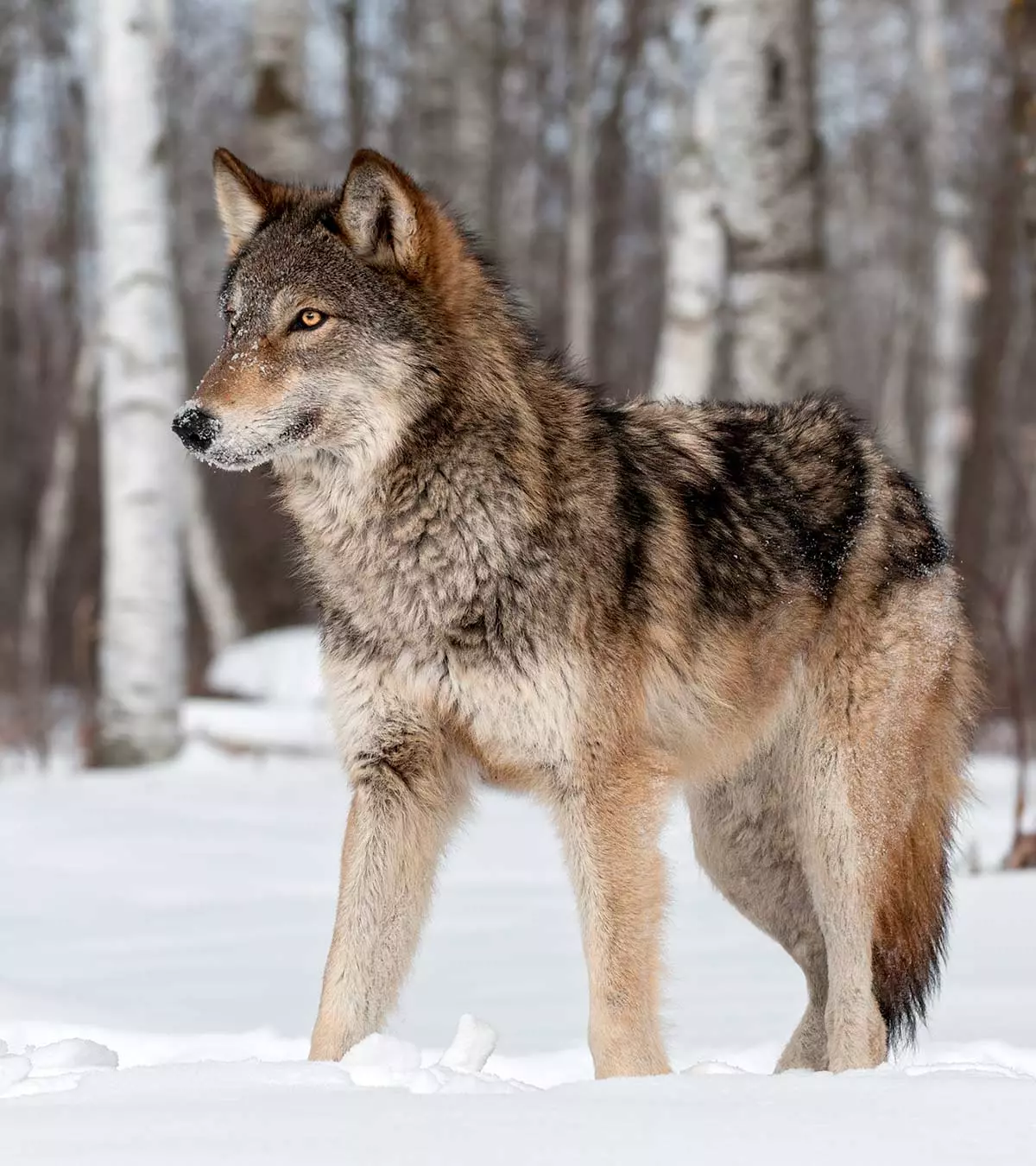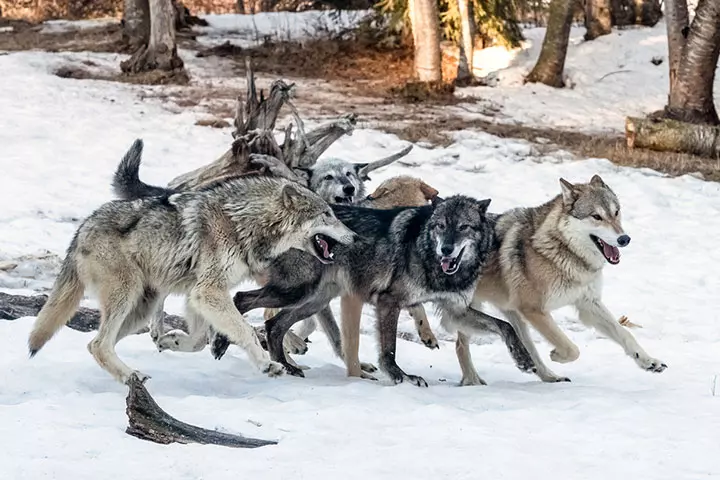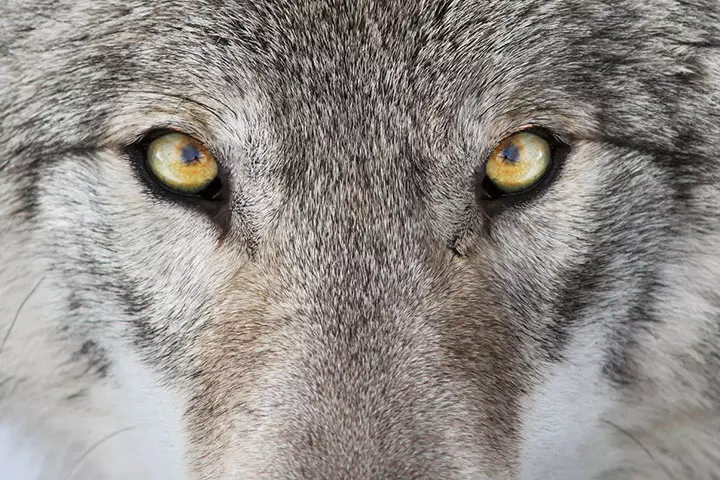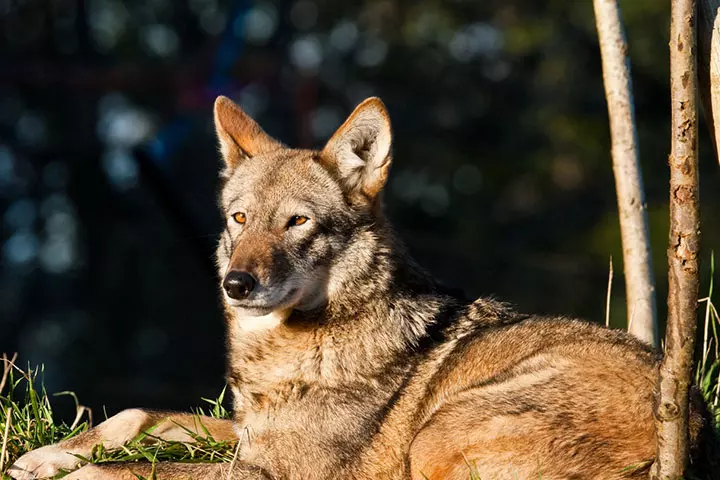
Image: ShutterStock
Many stories, especially fairy tales, show wolves as villains and those carrying mysteries. Wolf facts for kids are guaranteed to teach them a thing or two about these creatures. When your little one reads about them, they might have many questions—why do they howl at the moon when it is a full moon night or how they are related to humans. Wolf is from the wild dogs family, where other animals, including the gray wolf, arctic wolf, white wolf, and Mexican wolf, also come under this broad umbrella. To learn more about these interesting creatures, check out this post with some of the best wolf facts for children to learn.

Key Pointers
- Wolves devour their prey within minutes after hunting, utilizing their innate hunting abilities.
- Wolves communicate using noises, postures, and rituals to interact with each other.
- The pack of wolves is led by the alpha pair who are also responsible for breeding.
- The optimal breeding period for wolves is from March to May, with female wolves giving birth to around four to six pups per litter.
- Wolves can survive up to 13 years in their natural habitat and up to 16 years in captivity.
25 Amazing Wolf Facts For Kids
The wolf is a majestic animal that many children adore for their strength. They are apex predators, placing them on the top of the food chain. Not just that, wolves are also keystone species. When they are absent from their ecosystem, smaller predators multiply exponentially, reducing the number of small prey, while larger animals, like elk, deer, and moose, thrive, stripping the highlands of vegetation (1). Read on to fascinate your children with more such facts about this special animal.
1. Hunters by birth
Known to be vicious hunters, the wild dogs head out as a pack to hunt their prey. They tend to look for weakness, targeting weak, sick, or elderly animals (2). After they hunt their target, the wolves devour their prey within minutes.
Wolves are known to hunt animals called ungulates, which are generally large and hoofed. For instance, the white-tailed deer is the wolf’s primary prey in Wisconsin and Minnesota. Other animals, like elk, caribou, mountain goats, and bison are also targets by wolves (3).
The animals exhibit a few traits of humans, such as the fact that they live in close-knit families (4). Once born into the family, wolves stay close to the pack for as long as they live.
2. Ancestry
The wolf is known to be the ancestor of every known breed of dogs. Studies show that dogs can be traced back to two ancient wolf populations, primarily the gray wolf, the domestication of which occurred during the Ice Age 15,000 years ago. Modern dogs, however, are more genetically similar to Asian wolves, which suggests that wolves may have been domesticated more than once, after which they intermingled (5).
Wolves may not be friendly like your cute canine, though. They play around just like dogs, pushing and fighting with each other. Unlike dogs, they do not bark. Genetically they are identical and even capable of interbreeding.
Despite their close relation to dogs, wolves find a meal in dogs. Wolves are opportunistic predators, so it is said that a single wolf can solicit a dog to follow it, and once it corners the prey, the other partners in the pack join the wolf to reduce the dog to shreds.
3. Weighty issue
Male wolves typically weigh anywhere between 65 to 175 pounds, and females weigh a few pounds less, at around 25 to 125 pounds (6). The farther they are from the equator, the heavier they grow. The largest wolf to have ever been killed weighed over 175 pounds, back in 1939 in east-central Alaska (7). Russian gray wolves are the largest species, weighing an average of 152-176 pounds, while the Arabian gray wolf is the smallest in the world, weighing an average of 45 pounds (8).
 Trivia
Trivia4. No mercy
Wolves aren’t exactly known for their speed, but they use this to their advantage. The entire pack goes chasing behind the potential meal, signaling and coordinating with each other. They have various techniques for communicating with each other, and this helps while hunting.
The entire pack attacks its target, with some biting the prey’s flanks and shoulders, some at the rear, and the others by the nose (2). They tear it off into pieces with their fangs and claws until the victim gives up the fight from exhaustion. They are said to eat their prey alive, unlike most other animals that wait until their prey is dead. They do not have any quick tricks to take the lives of their prey immediately and hence resort to eating them alive.
5. Wolf packs

Wolves move in packs that resemble cohesive family units. This is what sets wolves apart from most other animals. They hunt and breed in packs that range from two wolves to as many as 20. The size depends on their habitat and food supply. The alpha pair leads the pack and is the only pair of breeders. Once a mate is found, a couple is formed, and this is known as the alpha pair. A wolf finds a mate only once and sticks with that for the rest of its life. Although wolf packs tend to form through an alpha pair, they can also form through group dispersal or pack splitting (9).
6. Early life
The ideal breeding time for wolves is between March and May. A female wolf can give birth to around four to six pups at a time. Universally two species exist, the gray wolf and the red wolf. The pups are in constant need of attention from their mother as they cannot move or crawl when born. Born deaf as well as blind when they enter the world, pups are around 1 pound and reach 3.5 pounds by the time they are 3 weeks old (10). The entire pack is known to assist the mother in childbearing. Eight months is the time they take to join in the pack for hunts.
7. Wolf pups
When born, the pups thrive on their mother’s milk. They require around five feeds every day to keep growing. They start to eat regurgitated meat once they are around two weeks old, and this is when their first set of milk teeth begin to show. Once they are eight weeks old, the wolves move on from their mother’s milk for the kill of the pack. For a newborn cub to urinate, it requires a nice little belly massage from its mother, using her warm tongue.
The growth rate of wolf pups is quite fast as they gain close to about three pounds every week for the initial 14 weeks. When they are 15 days old, they get a glimpse of the world through a set of eyes with poor vision. They begin to move around and venture out of their den after three weeks of their birth. They start to tag along with the others only once they are 8-16 weeks old and join them on hunts by 14-27 weeks. This is when they abandon the den completely. By the time they are 1-3 years old, they begin showing dominant or submissive behaviors, which decides their future position in the pack (10).
8. Arctic wolves
Also called Polar wolves or white wolves, Arctic wolves are found in Arctic parts of North America and Greenland. Some wolves in the Arctic are known to survive for days without eating as they have to travel long distances in the forest in search of food.
An arctic wolf has a color like no other. It is white and is unique as it is found scarcely. In some regions, they show variations of yellow and black. Being three feet long, they weigh around 70-175 pounds (11). Some are known to be six feet long. They can live for up to seven years. The wolf is seen as an animal and a great teacher, a pathfinder of some sort.
9. Gray wolves
Gray wolves are also called timber wolves. They are white, black, or brown in color or a combination of the three and have black-tipped bushy tails. Adult wolves have huge feet with a paw print of 5 inches long and 4 inches wide. Male gray wolves weigh 70-145 pounds while females weigh 60-100 pounds (12). Gray wolves do not walk on their feet but on their toes. This they share in common with dogs. Their mouths are long and so are their tails. The average ground covered by a grey wolf is around 30 miles a day. They can leap far and wide, covering a large stretch of land. These animals are known to have two layers of fur, an undercoat and a top coat. This allows them to survive in extreme temperatures, the coldest being minus 40 degrees Celsius. Their fur is flattened in warmer places to keep them cool. They can also hear packs from around 20 miles away.
10. Eating habits
The carnivores’ prime prey are goats, beavers, deer, moose, and bison. A wolf by itself feasts on smaller animals such as rabbits and squirrels. When in a pack, they can take down animals as large as elk or moose. In one single sitting, a wolf can eat up to 20 pounds of food (12). Ranging from domestic animals, small mammals, carrion, small and large ungulates, wolves eat just about anything. Although wolves were seen as obligate carnivores, they may actually be facultative carnivores, seeing as blueberries form a part of their summer diets in the Great Lakes (13).
11. Royalty
When a kill has been made, while in some cases the alpha pair eats first, usually the youngest offspring are also fed first. Due to the irregularities in the availability of food, wolves eat up to one-fifth of their total weight. This is done to account for the missed food. The alpha pair is the oldest and most dominant member of the troop. The pair makes the decisions involving the pack, such as the right time to set out on the hunt, to move, and so on. Each of the other members is offered inferior roles to that of the alpha pair. Pups under the age of two are not promised a place in the pack. They constantly fight with each other in attempt to find the next top wolf.
12. Coexistence with men
For wolves to coexist with humans, it is important to remove all conflicts that exist with each other. Eskimos are known to hunt a large number of Arctic wolves. Wolves are killed for their skin. The attack of beasts on humans is also not uncommon, with more incidents reported in India and its neighboring regions than in any other part of the world. More than 200 attacks were reported in South Asia in 50 years up to 2002.
13. Threats
The only threat a wolf faces is the one from humans. They are at the top of the food chain and are unstoppable predators. Humans see wolves as a threat and tend to kill them for fear of their lives. Wolves in Britain have been hunted to a point of extinction. Now that wolves are being studied, a deeper understanding of these creatures has been obtained. Rabid wolves are extremely dangerous, and hence, vaccination is done. The Ethiopian wolf is on the verge of extinction with less than 500 remaining (14). It has been threatened by the spread of diseases by dogs that have been domesticated. A few organizations have been set up to protect these rare wolves.
14. Communication

Wolves communicate with each other through noise, postures, and rituals. They also leave indelible scent marks. In order to declare supremacy, dominant wolves look at the others right in the eye. When in the presence of their leader, the wolves lower their tails and bend low as an act of respect. The pack may also howl in some cases, but they normally communicate through growls, whimpers, and barks. When threatened, an open mouth, clenched teeth, and upright ears signify an angered beast (15). Being highly territorial creatures, wolves tend to shut out other wolves who do not belong to the pack. When marking their territory, wolves urinate all over the place. Their sense of smell is about 100 times better than humans (15). Objects over which the stench lingers belong to the territory being marked. The alpha male is usually in charge of things such as these.
15. Life span
Wolves can live for over 13 years with the average life being six to eight years. They can live for nearly 17 years in captivity (16). The wilder ones tend to die faster than captive wolves mainly due to starvation. Encroachment of forests is also a reason for their death.
16. Number of teeth
Known to have ten more teeth than humans (42 teeth), these animals tear their meals apart in no time with their canines, which can be 2.5 inches long (17). The skeletal system of a wolf goes by the lifestyle it follows. Their jaws need to be strong enough to bring their prey down to their mercy. Strong bones and flexible wrist bones give the wolf added benefits when compared to other animals. While running, these creatures require additional stability. This is provided by the radius and ulna bones.
17. Scary dog
Even though they are the ancestors of dogs, wolves tend to shy away from unfamiliar things and visitors rather than confront them like dogs do. A wolf lowers its entire body and draws its ears back as a sign of active submission. It might also lick its muzzle and lower its body. It looks up at the dominant animal and places its tail between its legs (15). This shows that the wolf is humbling itself before the unfamiliar. This indicates an active submission.
A submission can also be passive, wherein, the wolf rolls over and exposes its underside. They keep their paws closer to the body and whimper away (15). This kind of submission is found to be more intense when compared to active submission.
18. Eyes

Born with blue eyes, wolves get their true yellow eye color only once they are eight months old. A fully grown wolf has eyes that are often amber, with variations such as yellow, green, and gray. A wolf hybrid can easily be spotted by the fact that they have blue eyes. Adult wolves seldom have blue eyes. Wolves are said to have eyesight close to that of humans. They are known for their visual adaptation to rapid motion and the higher ratio of rods to cones. This helps in night vision. At night, a wolf’s eyes glow in the dark and their vision is at its peak and can overshadow that of a human (18).
19. Swimmers
The wild dogs are not just restricted to land. They can swim across distances that span up to eight miles. This is aided by the webs between their toes. Wolves take an occasional dip in the icy streams and lakes. Nothing stops them from jumping into the waters, not even their prey. For instance, the coastal wolves of Vancouver Island are known to swim far distances for mates, food, and territory (19).
They take baths during summer to keep themselves cool. Known to be quite the groomers, wolves spend a lot of time keeping their fur spic and span. Seen as a means to strengthen social bonds between members of the pack, the grooming process is quite intense. Help is received from all members, as they claw and lick the dirt away. Comfort and support are depicted through these rituals.
20. Hitler means wolf
The German dictator Adolf Hitler’s first name, Adolf, translated to ‘wolf.’ As a result, used a lot of code names associated with wolves for various operations. Hitler had a small part of his empire called the “Wolf’s Lair.” During World War II it served as his first military headquarters. It was located all through Europe in different parts, called the Wolfsschanze, Werewolf, and Wolfsschlucht, all named after his nickname, Herr Wolf or Mr. Wolf (20).
21. Howling tendencies
Did you know that if you imitated a wolf call, you might get a response? Some reasons have been found for a wolf call. Wolves in the pack howl together to protect and defend their territory. It begins with any one wolf yelling out and is followed by responses from the rest. They might even respond to anything similar to a wolf cry. Wolves also howl to locate other wolves, to warn their pack members about a danger, or to advertise their pack’s size. Wolf howls can be heard even 10 miles away in open land. Each howl can be distinguished by a pack member (21). They howl more often at night and during sunrise because they are more active at these times. A little-known fact is wolves howl less in the summer than in winter.
22. They find companions in the most unlikely of critters
Wolves are often accompanied by ravens. This is because the ravens feast on the aftermath of the hunt, which gives them the nickname “wolf birds.” To get the wolves away from the kill, these ravens peck away at the wolf’s tail to try and move them away. They are often seen interacting with wolves, especially young pups, playing with them and teasing them with sticks or pulling their tails (22).
23. Werewolves
For fear of their close resemblance to wolves, a large number of people were put to death in the 1600s, calling them werewolves. Some think they had lycanthropy, a mental disorder, where one may have an overactive imagination, leading them to behave erratically and violently like wolves. Werewolves have also been in storylines for several books, TV series, and movies, and in such cases, they stem from folklore. These stories show werewolves as supernatural beings, wherein their transformation is more illusory, rather than physical (23).
24. Food for thought
If you thought only cows were capable of chewing the cud, think again. Regurgitating is the process wherein the wolves carry chewed up food in their bellies and throw it up to serve their young. According to research by the Forest Service of the USDA, wolf pups received 81% of the regurgitated food, while breeding females and other auxiliaries received the rest (24). Speaking of the young, they, too, have toys to play with, just like humans. Their toys are feathers and bones of dead animals. Wolves also take pride in their victory over their prey and carry trophies around.
25. Red wolves

Yes, wolves could come in shades of red as well. They exhibit characteristics similar to most other wolves when it comes to diet except for the fact that these smaller wolves feed on berries and insects as well. These red critters find dens in trees and sand knolls. Known to exhibit high levels of unity within the pack, these animals communicate with the harmony of the highest forms.
Once faced with extinction, red wolves seemed to have beaten the odds into surviving for a very long time. The United States Fish and Wildlife Service (USFWS) declared red wolves extinct in 1980. Years later, this rare breed of wolves was bred in captivity, and USFWS has since been working on protecting and helping their population grow.
Here is a chart depicting the population of red wolves over the past few decades. The chart shows that the population peaked at 150 wolves in 2006, but illegal hunting led to a decline in the population. Red wolves were set to be extinct again by 2025, with only seven remaining wolves. As of October 2025, barely eight red wolves were known to remain in the wild in North Carolina. Because of court-ordered reintroductions, 25 red wolves are found in Albemarle Peninsula in eastern North Carolina today (25).

Population of red wolf over the years
Source: The Endangered Red Wolf; Wolf Conservation Center/USFWS/The Journal of Wildlife ManagementFrequently Asked Questions
1. What are wolves afraid of?
Wolves are most afraid of humans, probably due to the year-long human-led attacks and ill-treatment. Hence, wolves try to avoid human contact to protect themselves (26).
2. What is a female wolf called?
Female wolves are not known to have a specific name, but sometimes they may be called she-wolves. However, the female leader of the pack was earlier known as alpha (9).
3. How far can a wolf’s howl be heard?
A wolf’s howl can be heard over six to ten miles depending on the type of terrain that they live in (27) (21).
4. How fast can wolves run?
Wolves can trot at a speed of 5 miles per hour, demonstrating their steady pace. However, when the need arises, they can unleash short bursts of speed, reaching up to 35 miles per hour. This combination of endurance and occasional bursts of speed makes them effective predators (28).
5. How long is a wolf’s gestation period?
Gray and red wolves typically experience a gestation period, or length of pregnancy, of approximately 63 days. This relatively short period is vital for the development of wolf pups within the mother’s womb and ensures their readiness for birth and subsequent integration into the pack. The shortness of the gestation period reflects the efficiency of wolves in sustaining their populations (29).
This post on wolf facts for kids contains information about various attributes of these magnificent creatures. Wolves are commonly found in the continents of Europe, Asia, and North America and are also an intriguing subject of interest for children. So share this list of informative and fun facts about wolves with your child and provide them with excellent food for their thoughts. Also, explore science facts for kids so they can learn about ecosystems and the importance of preserving them.
Infographic: Why Are Wolves Important?
Wolves are majestic and charismatic animals with an aura of dominance. You will be fascinated to know how wolves are more than powerful predators. Check this infographic and use it to educate your children about the importance of wolves in maintaining a stable and functioning ecosystem. Illustration: Momjunction Design Team
Illustration: Interesting And Informative Wolf Facts For Kids

Image: Stable Diffusion/MomJunction Design Team
Learn amazing facts about wolves! From their diet to their social behavior, this video will give you an inside look into the lives of these majestic creatures.
References
- Wolves Are a Keystone Species.
https://www.californiawolfcenter.org/biodiversity - Predation.
https://wolfhaven.org/conservation/wolves/predation/ - Hunting and feeding behavior.
https://wolf.org/wolf-info/basic-wolf-info/biology-and-behavior/hunting-feeding-behavior/ - The social wolf.
https://www.livingwithwolves.org/about-wolves/social-wolf/ - Ice Age wolf DNA reveals dogs trace ancestry to two separate wolf populations.
https://www.crick.ac.uk/news/2025-06-29_ice-age-wolf-dna-reveals-dogs-trace-ancestry-to-two-separate-wolf-populations - Wolves.
https://www.ifaw.org/international/animals/wolves - Big Wolves and Ordinary Wolves: Wolf Weight Depends on When and What They Last Ate.
https://www.adfg.alaska.gov/index.cfm?adfg=wildlifenews.view_article&articles_id=503 - Types of Wolves Around the World.
https://www.seacrestwolfpreserve.org/types-of-wolves - Pack Structure.
https://wolfhaven.org/conservation/wolves/pack-structure/ - Wolf Pup Development: Physical & Social.
https://wolf.org/wolf-info/basic-wolf-info/biology-and-behavior/pup-development/ - Arctic Wolf.
https://www.worldwildlife.org/species/arctic-wolf - Gray Wolf.
https://www.nwf.org/Educational-Resources/Wildlife-Guide/Mammals/Gray-Wolf - Gray Wolves.
https://projectcoyote.org/act/learning-hub/wolf-profile/ - Ethiopian wolves.
https://ptes.org/grants/worldwide-projects/ethiopian-wolves/ - Communication.
https://wolf.org/wolf-info/basic-wolf-info/biology-and-behavior/communication/ - Gray wolf facts.
https://www.pbs.org/wnet/nature/river-of-no-return-gray-wolf-fact-sheet/7659/ - What big teeth you have!
https://wolf.org/wp-content/uploads/2019/09/wildkids_summer2019-1.pdf - Why Do Wolves’ Eyes Glow in the Dark?
https://nywolf.org/2025/05/why-do-wolves-eyes-glow-in-the-dark-4/ - Can you say, “wolfy paddle”?
https://nywolf.org/2019/07/can-you-say-wolfy-paddle/ - Other Hitler’s Headquarters in Europe.
https://wolfsschanze.pl/en/other-hitler-headquarters/ - Wolves and Howling.
https://nywolf.org/2017/02/wolves-and-howling/ - Naturalist Notes: Wolves and Ravens.
https://www.yellowstone.org/naturalist-notes-wolves-and-ravens/ - Lycanthrope or Werewolf.
https://quod.lib.umich.edu/d/did/did2222.0000.158/–lycanthrope-or-werewolf?rgn=main;view=fulltext;q1=Divination - L. David Mech et al.; (1999); Regurgitative food transfer among wild wolves.
https://research.fs.usda.gov/treesearch/13689 - Red Wolf.
https://defenders.org/wildlife/red-wolf - Who’s afraid of the big bad wolves.
https://wolf.org/wolf-info/basic-wolf-info/wolves-and-humans/whos-afraid-of-the-big-bad-wolf/ - Why Do Wolves Howl? And Other Top Wolf Questions Answered.
https://nationalzoo.si.edu/animals/news/why-do-wolves-howl-and-other-top-wolf-questions-answered - Wolf facts.
https://www.californiawolfcenter.org/wolf-facts - Wolf FAQs
https://wolf.org/wolf-info/basic-wolf-info/wolf-faqs/#toggle-id-10
Community Experiences
Join the conversation and become a part of our nurturing community! Share your stories, experiences, and insights to connect with fellow parents.
Read full bio of Elisa Yi
Read full bio of Manjiri Kochrekar
Read full bio of Harshita Makvana
Read full bio of Trisha Chakraborty



















